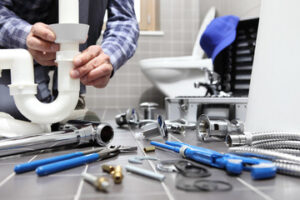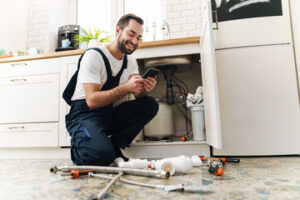Plumber Woodland Hills work with customers to understand their plumbing needs and provide recommendations. They also collaborate with other professionals, including construction teams and architects, to ensure plumbing systems are integrated seamlessly into building projects.

Plumbers often work in confined spaces and may need to lift heavy objects. This can lead to repetitive trauma injuries like carpal tunnel syndrome or tendonitis.
Leaking Pipes
Leaking pipes are a serious problem that can lead to water damage in your home, as well as mold and mildew growth. It can also increase your water bill due to the amount of water being wasted. The good news is that there are several quick fixes you can try before calling a plumber.
The first step is to turn off the water supply valve to the affected pipe. This will stop the flow of water and prevent any further damage from occurring. Once the water has stopped flowing, you can wipe up any standing water and start to assess the damage.
If the leak isn’t too severe, you can use a rubber repair sleeve to create a permanent seal. These sleeves can be found at most hardware stores and are designed to wrap around the damaged area of the pipe, creating a strong, impermeable seal that will stop the leak. If the leak is too large to hold back with a repair sleeve, you can use a piece of rubber hose that is cut just a little bit longer than the leak and then wrapped around it to create a tight seal. These quick fixes should help reduce the water damage caused by your leaking pipes and give you time to call a professional plumber.
Another common cause of leaky pipes is poor workmanship. This can be caused by a plumbing job done by a non-plumber or by homeowners trying to do DIY plumbing projects. Incorrectly laying pipe and connections, as well as using the wrong type of fittings for the pipe type, can all cause leaks. If you have recently had plumbing work completed or are concerned about the quality of the plumbing in your home, a plumber can conduct an assessment and provide recommendations for any needed repairs.
It is important to note that if the leak is caused by damage to your property, such as a hole in the roof or walls, you may need to file an insurance claim. However, if the leak is caused by normal wear and tear or by aging, you likely won’t be able to get any compensation from your insurer.
Sewer Backup
If sewage backs up into your home, you must act quickly. Raw sewage is dangerous to touch or breathe in, and it can damage your floors, walls and possessions. It also poses health risks for you and your family. You should avoid all contact with sewage until a professional plumber has cleaned and sanitized the affected area.
There are several things that can cause a sewer line to back up. Some are preventable, and some you can’t control. If your municipal sewer system gets overwhelmed during heavy rain or a rapid snow melt, it can cause a backup in your house. You can prevent this by having a backwater valve installed. Other causes include a drain clog or something being flushed down the toilet that shouldn’t be. For example, you should never pour cooking oil down a drain or toilet. Instead, it should be put in a heat-resistant container and disposed of properly.
An emergency plumber can help you avoid a sewage backup by removing the source of the clog. Depending on the situation, you may need to evacuate the area and clear any items in your home that could be damaged by standing sewage. Turn off the power to any flooded areas, and do not use any appliances until the area has been cleaned and sanitized. It’s also a good idea to open windows and doors in order to increase ventilation and reduce the concentration of foul odors.
Having an emergency plumber on hand can save you time and money. An emergency plumber can diagnose problems and repair them promptly to prevent a sewage backup from damaging your home. In addition, an emergency plumber can help you understand your insurance policy. Most insurers offer coverage for sewer damage, but it’s important to read the fine print and speak with an agent so you’re clear on what is and isn’t covered.
A sewer backup can be a major hassle and health risk, but it’s not uncommon. Many common plumbing issues, like a slow-moving drain or gurgling noises, are signs of a potential sewer problem. By paying attention to the signals your body gives you, and acting promptly when needed, you can protect yourself from serious water or sewage damage.
Overflowing Toilet
Overflowing toilets are not only messy and unattractive, but they also can cause water damage to flooring and walls that may require costly repairs. The most common causes of overflowing toilets include clogs and problems with the sewer line. To minimize damage, it is important to call an emergency plumber right away when you notice a problem.
If the overflow is caused by a clog, you can often clear it with household products like a plunger. However, if the overflow is caused by a broken toilet part or a problem with the septic system, you will need to contact a professional plumber to resolve the issue.
Before calling for an emergency plumber, you should turn off the water to your toilet. You can usually find the shut off valve located in the floor or wall behind your toilet. The valve is usually a large knob that is connected to pipes, and you can turn it clockwise to shut off the flow of water.
Next, you should try to remove any water that has spilled onto the floor. It is best to use a towel or Shop-Vac for small spills, but you can also open your bathroom windows to help dry larger areas of moisture. Be sure to take extra sanitizing measures afterward to avoid bacteria contamination in the area.
If the overflow is caused by a problem with the toilet tank, you can open up the back of the tank to fix the issue. The tank float is responsible for controlling how much water flows into the toilet bowl after each flush. If it is positioned too high, this can lead to overflowing. You can lower the float by hand or with a bucket, and you can even put something heavy inside the tank to prevent it from rising up again. Be sure to close the tank lid once you are done!
Flooding
Flooding is a major problem that can cause extensive water damage in a short amount of time. It can also lead to mold growth and create a health hazard for you and your family. If you experience flooding in your home, it is important to turn off the water supply valve so that the excess water can stop flowing and call an emergency plumber right away.
Another reason to call an emergency plumber is if your hot water heater stops working. While it may not be a huge deal if you only use hot water for showers and washing clothes, if you need it for medical or other reasons, it is a serious issue that requires immediate attention. A great 24-hour plumber will be able to diagnose the problem and provide you with options for quick and affordable repairs.
If you have a clogged toilet that won’t budge, it is definitely a plumbing emergency. It could be a sign of a bigger issue, like a broken pipe or septic tank, and can cause severe flooding and damage to your home. A professional plumber will use tools to clear the clog and determine what is causing it. They will then be able to fix the problem or install a new toilet if needed.
Sewage backup is another serious plumbing problem that requires an emergency plumber. It can be extremely dangerous for your family and can cause serious damage to your home if not taken care of immediately. A sewer backup usually occurs when there is a clog in the pipes outside of your house or in the main line from your septic tank. Emergency plumbers will be able to find the clog and clean it out or, in some cases, will need to dig up and replace your entire sewer system.
Whether you have an urgent situation that needs to be dealt with right away or just need help fixing a minor problem, an emergency plumber is there for you. They will be able to come to your aid in no time and provide you with the assistance you need to get back on track. Just be sure to ask about their rates and what they charge for materials before hiring one.


